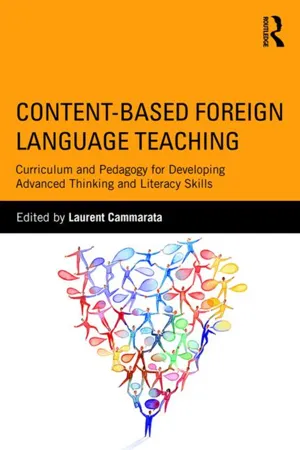
Content-Based Foreign Language Teaching
Curriculum and Pedagogy for Developing Advanced Thinking and Literacy Skills
- 276 pages
- English
- ePUB (mobile friendly)
- Available on iOS & Android
Content-Based Foreign Language Teaching
Curriculum and Pedagogy for Developing Advanced Thinking and Literacy Skills
About this book
Pushing the field forward in critically important ways, this book offers clear curricular directions and pedagogical guidelines to transform foreign language classrooms into environments where stimulating intellectual curiosity and tapping critical thinking abilities are as important as developing students' linguistic repertoires. The case is made for content-based instruction—an approach to making FL classrooms sites where intellectually stimulating explorations are the norm rather than the exception. The book explicitly describes in detail how teachers could and should use content-based instruction, explains how integration of content and language aims can be accomplished within a program, identifies essential strategies to support this curricular and pedagogical approach, discusses issues of assessment within this context, and more.
Content-Based Foreign Language Teaching provides theoretical perspectives and empirical evidence for reforming curricula and instruction, describes models and curriculum planning strategies that support implementation of well-balanced FL programs, explores the transformative potential of critical pedagogy in the FL classroom, and offers illustrations of secondary and post-secondary language programs that have experimented with alternative approaches. Advancing alternatives to conventional curriculum design, this volume posits meaning-oriented approaches as necessary to create language programs that make a great difference in the overall educational lives of learners
Frequently asked questions
- Essential is ideal for learners and professionals who enjoy exploring a wide range of subjects. Access the Essential Library with 800,000+ trusted titles and best-sellers across business, personal growth, and the humanities. Includes unlimited reading time and Standard Read Aloud voice.
- Complete: Perfect for advanced learners and researchers needing full, unrestricted access. Unlock 1.4M+ books across hundreds of subjects, including academic and specialized titles. The Complete Plan also includes advanced features like Premium Read Aloud and Research Assistant.
Please note we cannot support devices running on iOS 13 and Android 7 or earlier. Learn more about using the app.
Information
1
Content-Based Instruction and Curricular Reforms
Introduction
The Crisis of FL Education and the Need for a Philosophical Reflection
Failure of a System
Re-envisioning FL Education as a Discipline: Where Should We Begin?
Appraising the “True” Potential of FL Education
Beyond Language as a Tool for Communication
The Potential of FL Education to Support Learners’ Intellectual Empowerment
The Potential of Foreign Language Learning for the Development of Self-Consciousness
Table of contents
- Cover
- Title
- Copyright
- Dedication
- CONTENTS
- Preface
- 1 Content-Based Instruction and Curricular Reforms: Issues and Goals
- PART 1 Theoretical Perspectives and Empirical Evidence
- PART 2 Curriculum Development for the Thinking-Oriented Foreign Language Classroom
- PART 3 Critical Pedagogy and the Foreign Language Classroom
- PART 4 Exemplars of Cognitively Engaging Curriculum Planning for the Foreign Language Classroom
- About the Contributors
- Index